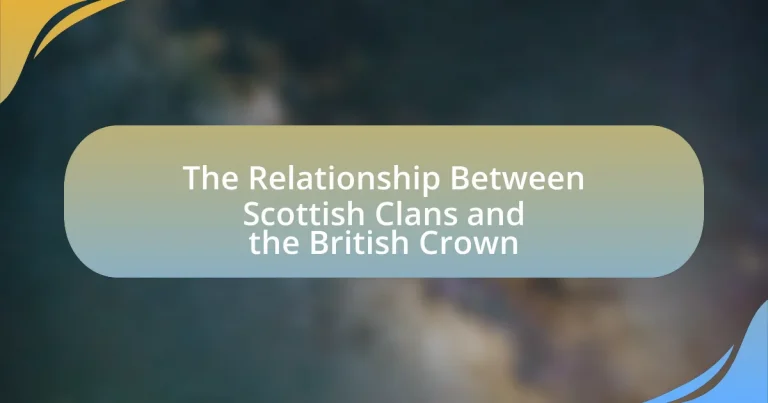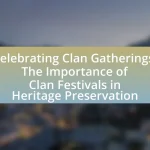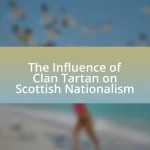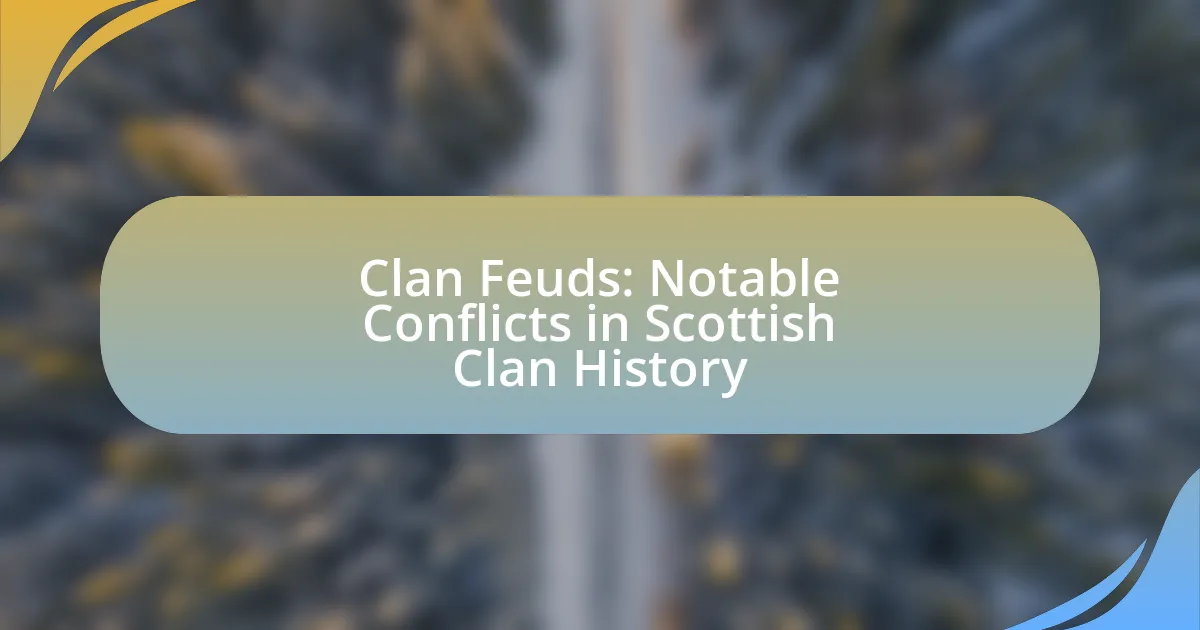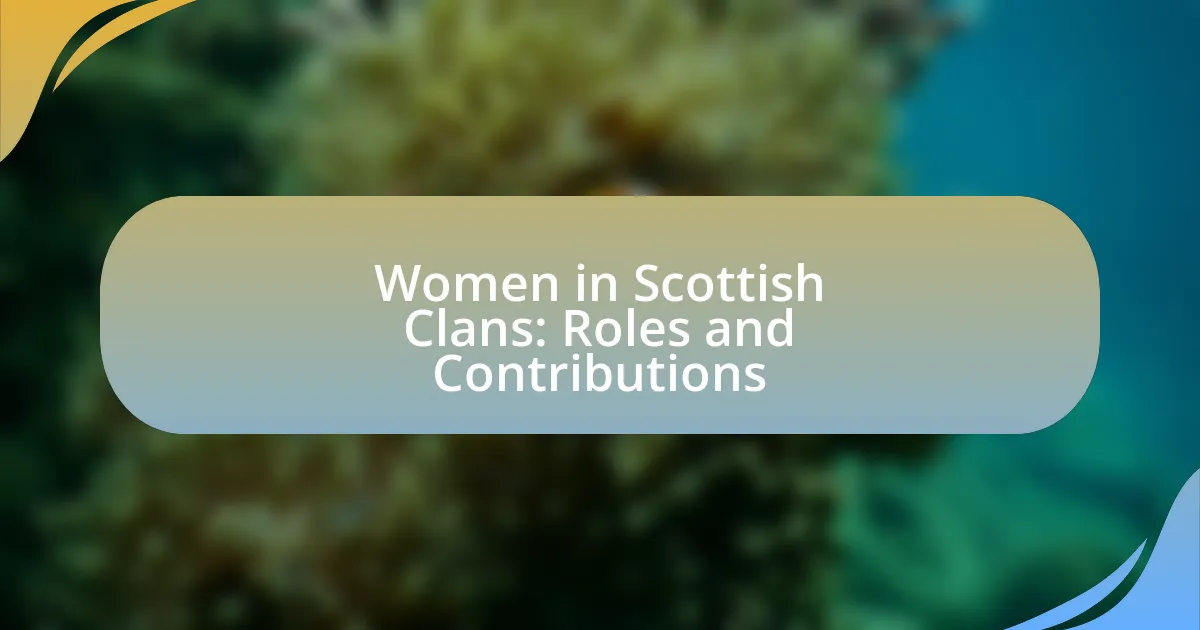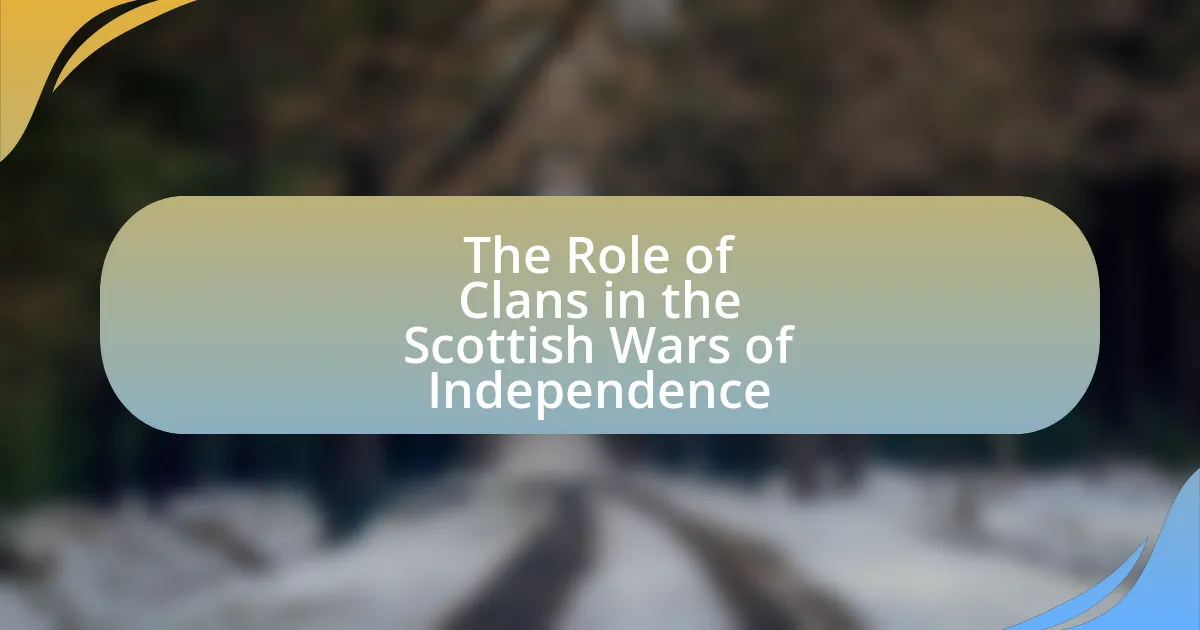The article examines the historical relationship between Scottish clans and the British Crown, highlighting a complex interplay of loyalty and rebellion. It details the origins and evolution of Scottish clans, their significant role in key historical events such as the Wars of Scottish Independence and the Jacobite uprisings, and the impact of Crown policies on clan structures and identities. The article also explores contemporary implications of this relationship, including cultural preservation, political representation, and the ongoing engagement of clans with the British monarchy, while addressing the challenges they face in maintaining their heritage and autonomy.
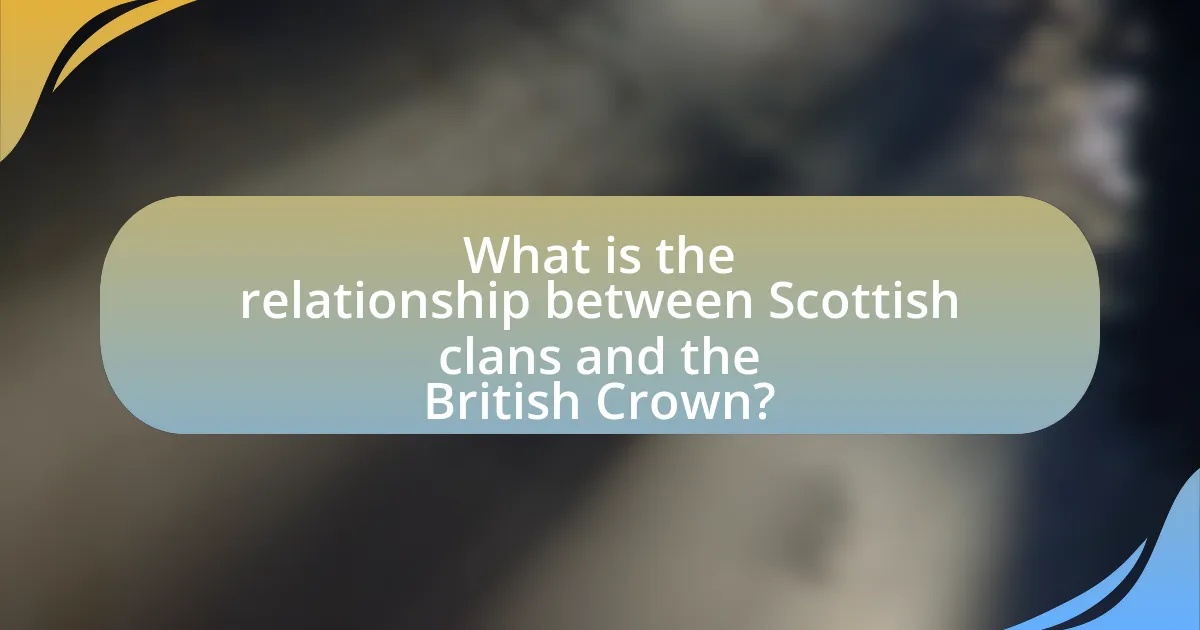
What is the relationship between Scottish clans and the British Crown?
Scottish clans historically had a complex relationship with the British Crown, characterized by both loyalty and rebellion. Clans often pledged allegiance to the Crown in exchange for land and protection, particularly during the reign of James VI and I, who sought to unify Scotland and England. However, this relationship was strained during events like the Jacobite uprisings in the 17th and 18th centuries, where clans rebelled against the Crown in attempts to restore the Stuart monarchy. The aftermath of these uprisings led to significant repercussions for clans, including land confiscations and the suppression of clan culture, particularly after the 1746 Battle of Culloden. This historical context illustrates the dual nature of the relationship, marked by both cooperation and conflict.
How did Scottish clans originate and evolve over time?
Scottish clans originated in the early medieval period, primarily as kinship groups that provided mutual support and protection. These clans evolved over time, particularly during the 12th to 15th centuries, as they became more structured and hierarchical, often led by a chief who held land and authority over the clan members. The clans played a significant role in the social and political landscape of Scotland, especially during conflicts such as the Wars of Scottish Independence in the late 13th and early 14th centuries, where clan loyalty was crucial. The evolution continued into the 17th and 18th centuries, marked by the Jacobite uprisings, which further solidified clan identities but also led to their decline following the defeat at Culloden in 1746, when the British Crown imposed measures to dismantle clan structures and traditions.
What were the key historical events that shaped Scottish clans?
Key historical events that shaped Scottish clans include the Wars of Scottish Independence (1296-1357), which fostered clan loyalty and identity against English rule. The subsequent rise of the clan system was solidified during the 15th and 16th centuries, particularly through the establishment of clan chiefs as local leaders. The Jacobite uprisings, especially the 1715 and 1745 rebellions, further defined clan allegiances and their relationship with the British Crown, leading to the 1746 Battle of Culloden, which resulted in the suppression of clan culture and the disarming of clansmen. The 1747 Act of Proscription banned clan symbols and tartans, significantly impacting clan identity. These events collectively influenced the social, political, and cultural landscape of Scottish clans.
How did clan structures and leadership develop?
Clan structures and leadership in Scotland developed through a combination of social, political, and economic factors. Initially, clans emerged as extended family groups that provided mutual support and protection, often led by a chief who held authority based on lineage and kinship ties. Over time, these clans became more organized, with chiefs consolidating power and establishing hierarchies within their clans, often influenced by land ownership and military prowess.
The feudal system introduced by the Scottish Crown further shaped clan leadership, as chiefs were granted lands in exchange for loyalty and military service. This relationship with the Crown reinforced the chiefs’ authority and solidified clan structures, as they became responsible for governance, justice, and defense within their territories. Historical events, such as the Wars of Scottish Independence and the Jacobite uprisings, also played a significant role in shaping clan dynamics and leadership, as clans rallied around their chiefs in times of conflict, further entrenching their social structures.
What role did the British Crown play in the history of Scottish clans?
The British Crown played a significant role in the history of Scottish clans by exerting political control and influencing clan dynamics through various policies and military actions. Following the Jacobite uprisings in the 18th century, particularly after the Battle of Culloden in 1746, the Crown implemented measures aimed at dismantling the clan system, including the Act of Proscription, which banned traditional Highland dress and clan symbols. This was part of a broader effort to integrate Scotland into the British state and suppress any potential rebellion. The Crown’s actions fundamentally altered the social structure of Scottish clans, leading to a decline in their power and influence while promoting loyalty to the British monarchy.
How did the Crown’s policies affect clan loyalty and power?
The Crown’s policies significantly undermined clan loyalty and power by enforcing centralization and reducing the autonomy of Scottish clans. The imposition of laws such as the Disarming Act of 1746, which prohibited the carrying of weapons, directly weakened the military capabilities of clans, diminishing their influence and ability to resist Crown authority. Additionally, the abolition of traditional clan structures and the promotion of land clearances disrupted clan cohesion and loyalty, as many clansmen were displaced from their ancestral lands. These policies led to a decline in the traditional power dynamics that had previously allowed clans to operate independently and assert their influence in Scottish society.
What were the consequences of the Jacobite uprisings for clans and the Crown?
The consequences of the Jacobite uprisings for clans and the Crown included significant loss of power and land for the clans, alongside the consolidation of authority for the British Crown. Following the uprisings, particularly after the defeat at Culloden in 1746, the British government enacted the Disarming Act and other measures that dismantled clan structures and restricted traditional practices, leading to a decline in clan influence. The Crown, in contrast, strengthened its control over Scotland, implementing policies that aimed to integrate Scotland more fully into the British state, such as the Act of Union in 1707, which had already begun to centralize power. These actions resulted in a lasting shift in the balance of power, diminishing the autonomy of Scottish clans while reinforcing the authority of the British monarchy.
Why is the relationship between Scottish clans and the British Crown significant today?
The relationship between Scottish clans and the British Crown is significant today because it influences cultural identity, heritage preservation, and political dynamics in Scotland. This connection is rooted in historical alliances and conflicts, particularly during the Jacobite uprisings, which shaped Scotland’s national identity and its relationship with England. The ongoing recognition of clan heritage in contemporary society fosters a sense of belonging and community among Scots, while the British Crown’s acknowledgment of this heritage can enhance Scotland’s cultural tourism and economic development. Additionally, the relationship impacts discussions around Scottish independence, as clans often symbolize regional pride and autonomy, reflecting broader sentiments about governance and national identity.
How do modern Scottish clans interact with the British Crown?
Modern Scottish clans interact with the British Crown primarily through ceremonial roles and cultural preservation. Clans often participate in official events, such as the annual Royal Edinburgh Military Tattoo and other state functions, which highlight their historical significance and connection to Scottish heritage. Additionally, many clans maintain a relationship with the Crown by engaging in community events and promoting Scottish culture, which fosters a sense of identity and continuity. The British monarchy recognizes the importance of clans in Scotland’s history, as evidenced by the Crown’s support for clan gatherings and heritage initiatives, reinforcing the clans’ role in contemporary Scottish society.
What cultural impacts stem from the historical relationship between clans and the Crown?
The historical relationship between Scottish clans and the Crown has led to significant cultural impacts, including the preservation of Gaelic language and traditions. This relationship, characterized by both conflict and cooperation, influenced clan loyalty and identity, which are deeply embedded in Scottish culture. For instance, the Jacobite uprisings in the 18th century, driven by clan allegiance to the Crown, reinforced a sense of Scottish nationalism and pride, which persists today. Additionally, the Crown’s attempts to suppress clan culture, such as the Dress Act of 1746 prohibiting tartan, resulted in a cultural revival as clans sought to reclaim their heritage. These events illustrate how the dynamics between clans and the Crown have shaped contemporary Scottish identity and cultural expressions.
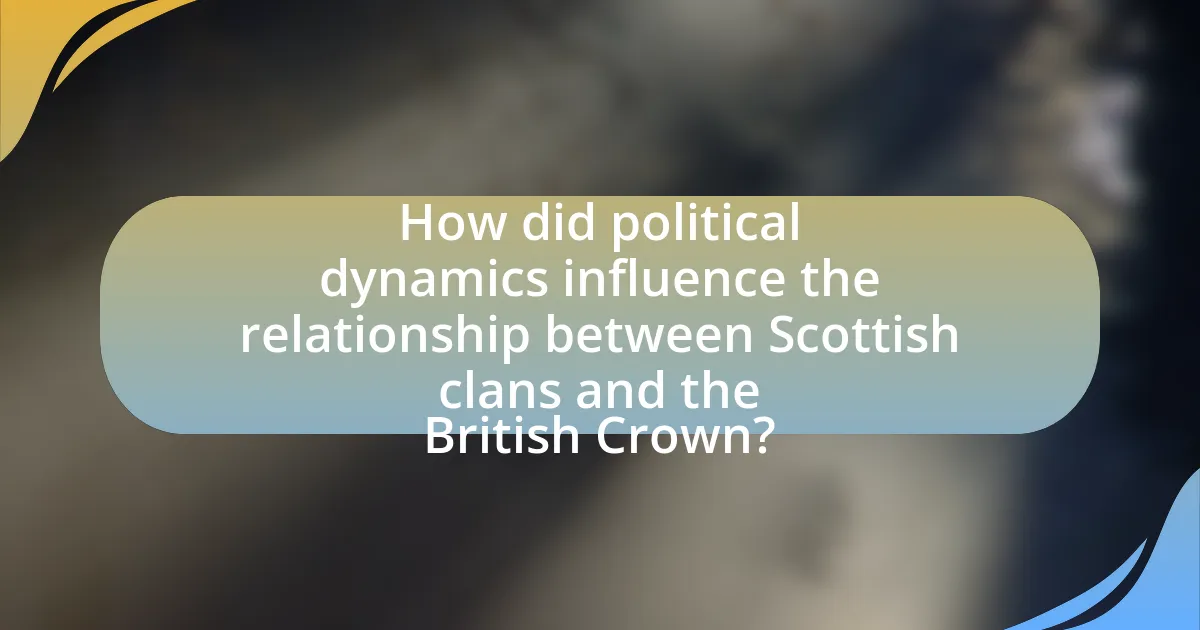
How did political dynamics influence the relationship between Scottish clans and the British Crown?
Political dynamics significantly influenced the relationship between Scottish clans and the British Crown by shaping alliances, conflicts, and power structures. The clans often aligned with or opposed the Crown based on shifting political interests, such as the Wars of Scottish Independence in the 13th and 14th centuries, where clans like the MacLeods and the Campbells played pivotal roles in supporting or resisting English rule. Additionally, the Jacobite uprisings in the 17th and 18th centuries, particularly the 1745 rebellion led by Charles Edward Stuart, exemplified how clan loyalty could directly challenge the authority of the British Crown, leading to severe repercussions for clans involved, including land confiscations and the suppression of Highland culture. These historical events illustrate that the political landscape dictated clan strategies and their interactions with the monarchy, ultimately affecting their autonomy and influence in Scotland.
What were the key treaties and agreements that defined this relationship?
The key treaties and agreements that defined the relationship between Scottish clans and the British Crown include the Treaty of Union (1707), the Act of Settlement (1701), and the Treaty of Edinburgh (1560). The Treaty of Union unified the Kingdom of Scotland and the Kingdom of England into Great Britain, significantly altering the political landscape and diminishing the autonomy of Scottish clans. The Act of Settlement established succession rules that affected Scottish claims to the throne, while the Treaty of Edinburgh marked an early attempt to stabilize relations between Scotland and England, addressing issues of governance and allegiance. These agreements collectively shaped the dynamics of power, loyalty, and conflict between the Scottish clans and the British Crown.
How did the Treaty of Union affect Scottish clans?
The Treaty of Union in 1707 significantly diminished the power and influence of Scottish clans by integrating Scotland into a unified Great Britain under English governance. This integration led to the suppression of clan culture and traditional structures, as the British Crown sought to centralize authority and reduce the autonomy that clans previously enjoyed. The subsequent Jacobite uprisings, particularly after the 1715 and 1745 rebellions, resulted in further punitive measures against clans, including the Disarming Act of 1746, which prohibited the carrying of weapons and aimed to dismantle clan loyalty. These actions effectively marginalized the clans, transforming their role from powerful local entities to subjects of the British state.
What role did the Act of Settlement play in clan politics?
The Act of Settlement, enacted in 1701, significantly influenced clan politics by establishing the Protestant succession to the British throne, which directly affected the allegiance of Scottish clans. This legislation aimed to prevent any Catholic from ascending to the throne, thereby aligning the interests of Protestant clans with the British Crown. As a result, many clans that supported the Jacobite cause, which sought to restore the Catholic Stuart line, found themselves increasingly marginalized and faced repression from the government. The Act solidified the divide between loyalist clans, who supported the Hanoverian succession, and those who resisted it, ultimately shaping the political landscape of Scotland in the early 18th century.
How did the British Crown utilize clans for military purposes?
The British Crown utilized clans for military purposes by leveraging their loyalty and local knowledge to bolster military campaigns. Clans, which were organized social units in Scotland, provided manpower and resources during conflicts, particularly in the Jacobite uprisings of the 18th century. For instance, during the Jacobite Rebellion of 1745, the Crown relied on clan leaders to mobilize their members for military service, effectively using their influence to gather troops. This strategy was evident when clans such as the MacDonalds and the Camerons supported the Jacobite cause, prompting the Crown to counteract by promising rewards and land to loyal clans, thereby ensuring military support in critical battles.
What were the implications of clan warfare on Crown authority?
Clan warfare significantly undermined Crown authority by fostering regional power dynamics that challenged centralized governance. The persistent conflicts among clans often led to the fragmentation of loyalty, as clans prioritized their own interests over allegiance to the Crown. For instance, during the 16th and 17th centuries, clan rivalries, such as those between the Macdonalds and the Campbells, resulted in violent confrontations that weakened the Crown’s ability to enforce law and order. This instability prompted the Crown to implement measures like the Statutes of Iona in 1609, which aimed to curb clan power and assert royal control, illustrating the direct impact of clan warfare on the Crown’s authority.
How did the Crown reward clans for their loyalty during conflicts?
The Crown rewarded clans for their loyalty during conflicts primarily through land grants, titles, and financial support. For instance, after the Jacobite uprisings, loyal clans received land in recognition of their allegiance, which solidified their status and influence. Additionally, the Crown often bestowed titles of nobility upon clan leaders, enhancing their prestige and power within Scottish society. Historical records indicate that following the 1715 and 1745 uprisings, clans such as the Campbells and the Grants were granted significant lands and privileges as a direct reward for their support against the Jacobites, reinforcing their loyalty to the Crown.

What are the contemporary implications of the relationship between Scottish clans and the British Crown?
The contemporary implications of the relationship between Scottish clans and the British Crown include cultural identity preservation and political representation. Scottish clans, as historical entities, continue to influence Scottish identity, fostering a sense of community and heritage that is recognized and celebrated within the broader context of the United Kingdom. This relationship is evident in events such as clan gatherings and the recognition of clan chiefs, which are supported by the Crown, reinforcing cultural ties. Additionally, the British Crown’s acknowledgment of Scottish clans can impact political dynamics, as clans often serve as a bridge between local communities and national governance, influencing discussions on autonomy and representation within the UK Parliament. This ongoing relationship reflects a blend of tradition and modern governance, highlighting the importance of heritage in contemporary political discourse.
How do Scottish clans maintain their identity in relation to the Crown today?
Scottish clans maintain their identity in relation to the Crown today through cultural events, legal recognition, and community engagement. Clans actively participate in Highland games and clan gatherings, which celebrate their heritage and foster a sense of belonging among members. Additionally, the Scottish Government recognizes clan chiefs as representatives of their clans, providing a formal structure that reinforces clan identity. This recognition is supported by the Clan Act of 2006, which acknowledges the historical significance of clans in Scotland. Furthermore, clans engage in charitable activities and local initiatives, strengthening their ties to both their communities and the Crown, thereby preserving their unique identities while navigating modern governance.
What events or ceremonies celebrate the connection between clans and the Crown?
Events and ceremonies that celebrate the connection between clans and the Crown include the annual Clan Gathering at the Palace of Holyroodhouse and the Highland Games. The Clan Gathering, held in Edinburgh, allows clan representatives to engage with the monarchy, reinforcing their historical ties. The Highland Games, celebrated across Scotland, often feature royal attendance, showcasing traditional Scottish culture and the enduring relationship between clans and the Crown. These events highlight the significance of clan heritage and loyalty to the monarchy, reflecting Scotland’s unique cultural identity.
How do clans engage with the British monarchy in modern times?
Clans engage with the British monarchy in modern times primarily through ceremonial events, cultural celebrations, and advocacy for heritage preservation. For instance, many Scottish clans participate in events such as the annual Gathering of the Clans, where members celebrate their heritage and often receive recognition from royal representatives. Additionally, clans may engage in charitable activities that align with the monarchy’s initiatives, fostering a sense of community and shared values. The British monarchy, particularly under Queen Elizabeth II and now King Charles III, has shown support for Scottish culture, further solidifying this relationship through public appearances and endorsements of clan-related events.
What challenges do Scottish clans face in their relationship with the Crown?
Scottish clans face challenges in their relationship with the Crown primarily due to historical grievances, cultural identity issues, and political representation. Historically, the aftermath of the Jacobite uprisings in the 18th century led to the suppression of clan culture and the disarmament of clansmen, creating a legacy of mistrust towards the Crown. Additionally, the centralization of power in the British government often sidelines the interests of Scottish clans, making it difficult for them to maintain their cultural heritage and autonomy. The lack of political representation in decisions affecting their lands and rights further exacerbates tensions, as clans feel their voices are not adequately heard in the broader governance of Scotland.
How do political changes in the UK impact Scottish clan dynamics?
Political changes in the UK significantly impact Scottish clan dynamics by altering the legal and social frameworks within which clans operate. For instance, the Acts of Union in 1707, which unified the Parliaments of England and Scotland, diminished the political autonomy of Scottish clans, leading to a decline in their traditional power and influence. Additionally, contemporary political movements, such as the push for Scottish independence, have reignited clan identities and affiliations, as clans often serve as symbols of regional pride and cultural heritage. The Scottish Government’s support for cultural initiatives further strengthens clan networks, demonstrating how political shifts can revitalize or diminish clan dynamics based on the prevailing political climate.
What are the future prospects for Scottish clans and their relationship with the Crown?
The future prospects for Scottish clans and their relationship with the Crown appear to be increasingly positive, as there is a growing recognition of the cultural significance of clans within Scotland. The Scottish Government has actively engaged with clan representatives to promote heritage and tourism, which fosters a collaborative relationship. Additionally, the Crown has shown interest in preserving Scottish traditions, as evidenced by events like the annual Clan Gathering at Holyrood Palace, where clan leaders are invited to engage with the monarchy. This engagement suggests a trend towards strengthening ties, as both parties benefit from the promotion of Scottish identity and heritage.
What can be learned from the historical relationship between Scottish clans and the British Crown?
The historical relationship between Scottish clans and the British Crown reveals a complex interplay of loyalty, conflict, and power dynamics. Clans often pledged allegiance to the Crown in exchange for protection and land, as seen during the reign of King James VI, who sought to unify Scotland under his rule. However, this relationship was frequently strained, particularly during events like the Jacobite uprisings, where clans rebelled against the Crown’s authority, aiming to restore the Stuart monarchy. The aftermath of these uprisings, particularly after the Battle of Culloden in 1746, led to significant repercussions, including the suppression of clan culture and the imposition of British law. This historical context illustrates the dual nature of the relationship, characterized by both cooperation and resistance, shaping Scotland’s national identity and its ongoing quest for autonomy.
